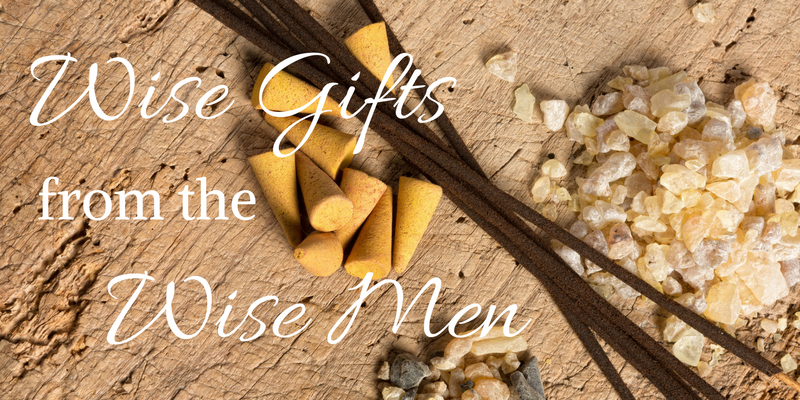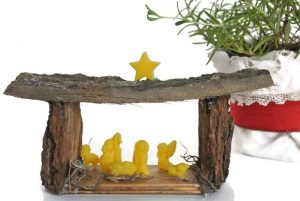 No doubt many of you have been preparing for Christmas by purchasing gifts for your loved ones. Our very first example of gift giving at Christmas was from the Magi. After their years-long trek to find the Christ Child, they presented Him with the priceless gifts of gold, frankincense, and myrrh.
No doubt many of you have been preparing for Christmas by purchasing gifts for your loved ones. Our very first example of gift giving at Christmas was from the Magi. After their years-long trek to find the Christ Child, they presented Him with the priceless gifts of gold, frankincense, and myrrh.
As an aromatherapist, I’ve studied the essential oils of frankincense and myrrh more in depth, and I realize how valuable — and useful — these gifts were to Mary and Joseph, Jesus’ parents. Let’s explore the interesting history of these two botanicals.
Frankincense, Boswelia carteri
In the ancient world, frankincense, a resin from a small, shrubby tree, was once considered more valuable than gold. Merchants traded it extensively along the Frankincense Trail and the Silk Road. In Christian tradition, frankincense was used by the Israelites in their worship of God. In Exodus 30, God gave Moses a new recipe for Holy Anointing Oil that was reserved only for the Tent of Meeting and the Ark of the Testimony. Additionally, Aaron and his sons (the priests) and many articles inside the Tent of Meeting were anointed with it. Frankincense was part of that recipe. It has long been considered a sacred oil in many cultures.
Besides it’s religious history, frankincense possesses medicinal properties that make it a healing oil. It would have been a powerful medicinal substance for Mary to treat her family with during the years they were traveling. Frankincense is anti-inflammatory, antimicrobial, anxiolytic, a nervine, vulnerary, and an immune enhancer.
When blended in a cream, it is wonderful for skin conditions of all types. As an inhalant, it helps to dry up congestion in the lungs. When used in a cream or salve and smoothed over a wound, it enhances healing after sutures have been removed. It blends well with myrrh, lavender, lemon, Roman chamomile,and helichrysum. The ancient Egyptians used it to treat everything from head to toe, and they used frankincense to make kohl, the black powder Egyptian women painted on their eyelids. Before the day of modern antibiotics, frankincense an d myrrh were the primary antimicrobial, antibiotic substances.
d myrrh were the primary antimicrobial, antibiotic substances.
This was a valuable gift for Jesus’ family. Besides using it medicinally, they could have also sold it to
finance their trip to Egypt.
Myrrh, Commiphora myrrha
You may not be as familiar with myrrh as you are with frankincense, but myrrh was once again an incredible gift to bless the young family with. Myrrh comes from the needles, trunk, stem, and branches of a small, shrubby tree. In the Old Testament, myrrh was also part of the recipe of the Holy Anointing Oil. Additionally, it was used in a recipe for powder placed in front of the Testimony in the Tent of Meeting. People used to wear pouches of frankincense and myrrh around their necks as perfume and also to benefit from their medicinal properties.
Beauty Treatments
In the book of Esther in the Bible, Esther received 12 months of beauty treatments before she was presented to King Xerxes. The first six months of treatment was with oil of myrrh. I’ve always wished I knew exactly what the formulas contained!
The most interesting fact I found about myrrh is that when the soldiers were preparing Jesus for crucifixion, Mark 15:23 tells us that they offered Jesus wine mixed with myrrh (probably to buffer the pain), but He would not take it. Jesus wanted to fully experience the cross. It is significant that myrrh was part of the beginning of His life and the end of His earthly life.
In aromatherapy, myrrh is know historically for being an analgesic, anti-inflammatory, anti-infectious, antimicrobial, antiparasitic, antiseptic, antiviral, endocrine regulator, and a vulnerary. It is wonderful for periodontal disease. It’s healing for the respiratory system and also for assorted skin diseases like ulcers, athlete’s foot, eczema, and acne. Myrrh blends well with cypress, frankincense, geranium, juniper, lavender, mandarin, patchouli, sandalwood, Scotch pine, tea tree, and vetiver.
I am amazed at how perfectly God provided for the needs of Mary, Joseph, and Jesus with the gifts of
(gold), frankincense, and myrrh.
Recipe for Today
If you’d like to try frankincense and myrrh, here’s a recipe you can mix up using either an unscented cream or oil.
Frankincense and Myrrh Skin Oil
Update: Or~ I found a blend that contains frankincense, myrrh, cedar and vanilla that will be a cheaper option because it’s all combined in one product. You can check it out here:
Frankincense & Myrrh Synergy Blend 
If you go with this option, simply add 36 drops of this blend to your cream.
Directions: Mix the synergy of all your essential oils together first. You can use a small shot glass or other glass or ceramic vessel. Don’t mix them in plastic. Stir the synergy into the cream or oil and mix well. Once the synergy has been mixed into an oil or cream, it can then be stored in a plastic or glass container. Smooth onto skin as needed. This is a 3 percent dilution, which is intended for adult use. Pregnant or nursing women should consult with a doctor before using products containing essential oils. Check WebMD for information on specific drug interactions or chronic illnesses that you may have before using essential oils.
I’m sure you’ll find that frankincense and myrrh are wonderful oils to have and use just as they were for Mary and Joseph over 2000 years ago. It may be that you want to follow the example of the Magi and give a gift of the Frankincense and Myrrh Skin Oil or Cream to someone special this year.
Merry Christmas!

Just a note: *This post does contain affiliate links. I do make a small profit if you purchase any products through my links. I only link to products I use myself, have heard are reputable, or are on my own want-to-try list. If you do choose to purchase a product through my link, thank you so much.

 nativity scenes from tree bark from Hickory & Oak Sawmill and Lumber Company (my brother-in-law’s sawmill) and from beeswax. I sell them at Christmas in my Etsy shop if you would like to add one to your home.
nativity scenes from tree bark from Hickory & Oak Sawmill and Lumber Company (my brother-in-law’s sawmill) and from beeswax. I sell them at Christmas in my Etsy shop if you would like to add one to your home.






 No doubt many of you have been preparing for Christmas by purchasing gifts for your loved ones. Our very first example of gift giving at Christmas was from the Magi. After their years-long trek to find the Christ Child, they presented Him with the priceless gifts of gold, frankincense, and myrrh.
No doubt many of you have been preparing for Christmas by purchasing gifts for your loved ones. Our very first example of gift giving at Christmas was from the Magi. After their years-long trek to find the Christ Child, they presented Him with the priceless gifts of gold, frankincense, and myrrh. d myrrh were the primary antimicrobial, antibiotic substances.
d myrrh were the primary antimicrobial, antibiotic substances.